CUT TO:
Yves Adrian, student. Trying to put his life back together, Yves decides to pursue a career as a cheese maker. His brother raises cows on a farm not far from Panou's village.
They agree that Yves will move to his brother's place after he finishes one year of training at France's elite school of cheese making, which has 300 students, all of them younger than Yves. He will make and sell cheese from the milk produced by his brother's cows.
But when Yves picks up and moves his family to the center of France, he discovers that his brother is in the middle of a divorce settlement that forces him to sell his farm and cows.
CUT TO:
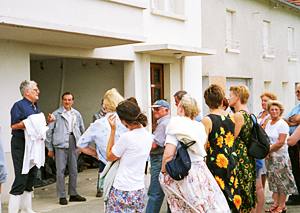 |
| Yves launching a tour of his cheese-making dairy. He is a born promoter. |
Yves and his wife, Nicole. They put the last of their money in a small farm, where they begin buying milk
from local milk producers to make cheese. While Yves supervises production, Nicole drives a truck
every day to surrounding villages and markets, doing the selling.
They make mostly knock-offs of well-known brands. There is no secret formula for making any cheese.
Anybody can make a Brie-like cheese, for example--as Yves did--so long as you don't call it Brie,
which is protected by its AOC. Of course no knock-off Brie or Camembert tastes exactly like the
real thing--and that is the movie magic of cheese.
Their business starts slowly but is soon rolling. Yves proves to be an imaginative marketeer.
His knock-off of a Münster he calls "L'Ami Fritz." He makes 32 different kinds of cheeses.
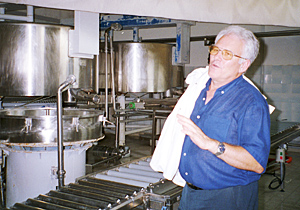 |
| Yves explaining how to make Chambérat.
The French love for cheese is so great that the tour group hangs on his every word. |
While Yves and Nicole struggle to survive, they hear tales of a wonderful farm-made cheese
that has disappeared from the region, smothered by the spread of supermarkets.
The cheese is called Chambérat, and the written documentation for its existence goes back to 1742.
But the recipe for making the cheese has been lost.
Or has it? Yves hears of an old grandmother who still makes Chambérat.
CUT TO:
La Grand Mère. Yves persuades the old grandmother to teach him the technique for making
Chambérat. When a small dairy, which is located not far from Panou's village, comes up for
sale in 1989, Yves and Nicole borrow enough money to make the purchase.
Yves goes into production, and the Chambérat is an immediate hit.
"It was an unusual situation," Yves says. "The market for the product existed--
but the product didn't."
Gault et Millau cite the cheese in their famous restaurant guide. The story of Yves and
Chambérat is written up in a book of cheeses under the title "History of a Renaissance."
By now Yves and Nicole are not only a husband and wife with two kids but also a smoothly efficient business team.
Nicole handles the books and does the selling. Yves maintains a strict quality control of the cheese.
Their staff grows to twenty. But Yves wants to keep the business small.
"Too much expansion is the death of quality," he says.
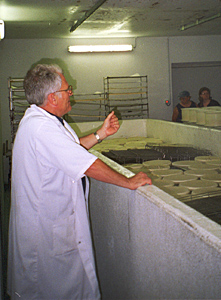 |
| The cheese is washed daily in salt water.
Suddenly, as if by magic, its crust turns a pink salmon color. |
CUT TO:
La Laiterie du Chalet, which is the name of his cheese- making dairy.
Yves sends out a tank truck every day to bring the raw milk--lait cru--directly from
32 local producers who farm milk cows. He wants to start out his cheese with the freshest milk possible.
The unpasteurized milk is transferred to several huge thermos-bottle-like storage tanks.
Then it is fed by pipes to vat, where the transformation from milk to cheese begins each morning.
It takes 75 gallons (300 liters approx.) of milk to make 27 cheeses.
Rennet, the enzyme used to curdle the milk, is added to the vat and the mixture is heated to
36 degrees Celsius (about 96 degrees Fahrenheit). In 15 minutes it begins to look like lumpy buttermilk.
After several more steps the hot mixture is placed in a cold room in individual molds.
The next morning it is de-molded, and the daily salt water washing begins.
Six weeks later the cheese is ready for the market.
Slowly, as if by magic, the crust of the 3-pound cheese begins to take on a delicate pink salmon color.
The round cheeses are delicious looking, a cave full of Chambérat is a sight to behold.
The cheese smells and tastes like a farm back in the days when no chemicals or genetic
altering was used, when everything was natural.
With the success of his enterprise, Yves encourages four women producers to
re-establish the tradition of "the grandmothers" by making Chambérat on their farms.
It's not easy. To set up a farm production of the cheese costs $20,000.
But to the French, no cheese tastes better than the one that bears the stamp
"fermier"--farm-made.
With Chambérat doing so well, and with exports showing up as far away as Texas,
Yves turns his attention to trying to win the Academy Award of cheese, the much
sought after but seldom granted Appellation d'Origine Contrôlée--AOC.
Yves is a born promoter who conducts two-hour tours of his cheese-making dairy for anyone
who wants to sign up, patiently answering every question about the process, even from children.
At the end of a tour, Yves and Nicole sell their cheese to the tourists.
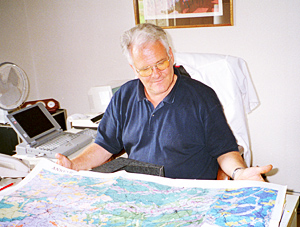 |
| Yves with a geological map, part of the AOC file.
Winning an AOC is incredibly complex. |
But Yves realizes that winning an AOC will require more than promotion and good media relations.
The AOC is a trade-mark of quality, an award for the highest talent, like Marlon Brando in
"A Streetcar Named Desire" or Vivien Leigh in "Gone with the Wind."
CUT TO:
Yves Adrian at his desk, studying a geological survey map. To win an AOC is an incredibly complex process.
In the case of Yves, so far it has required five years of research and the expenditure of $70,000.
The first step is to prove that you have a historically-based product. The longer it has been
around the better your chances for an AOC. If it has been in existence only for several years,
even a decade, no matter if it's wine or cheese--forget about it.
In this case, proving Chambérat's longevity is not a problem. Official records refer to the
cheese as far back as 1742, and it appears in a translation of La Fontaine's fables in the 19th century.
The second and most difficult step is to establish the "terroir" of the cheese. Terroir is one of the most
important words in the French language, but you won't find it adequately defined in any dictionary.
My Harrap's English-French dictionary simply defines it as "soil."
No, no, no--that misses it by a mile.
Sure, terroir means earth or soil, but so much more is involved, some of it mystical and inexplicable.
To begin with, terroir means the soil of your own community, plus the other elements that go with it,
such as the climate, the vegetation, the contours and altitude of the terrain.
If I speak about the terroir, I'm speaking about my specific place. If you speak about the terroir,
you are speaking about your specific place. It is the only holy word outside religion.
To win an AOC, you must convincingly demonstrate that your cheese (or wine) comes from
your terroir and produces a taste that is unique and unlike any other from another terroir in France.
And your terroir must be a specifically defined area.
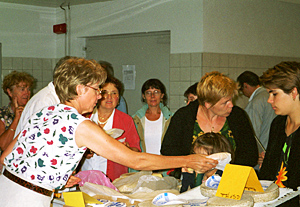 |
| Nicole selling cheese after the tour. Yves pitches in to help. |
For Chambérat, Yves claims a terroir that is 70 kilometers (42 miles) long and 55
kilometers (33 miles) wide. It extends from Panou's village southward to encompass
several other villages.
Once the terroir is established, Yves begins to collect documentation to prove that the
area of Chambérat is unique to France. He submits soil samples, demonstrates that
the microclimate is this area's alone, that the grass and foliage, all the contributing factors
to the terroir, have their own special identify.
The file grows thick and Yves finally submits it, in 1997, to the National Institute of AOC.
A delay of 42 months between submission and approval is normal. The word comes
back from the Institute that the Chambérat file looks good. But there is one major flaw.
The milk used to make Chambérat must come from cows that only eat grass
from Yves's terroir. Some of his milk producers import soy from the United States
to feed their cows. They must stop if the AOC is be granted.
This is a difficult task. French farmers are individualists who hate regulation of any kind.
But Yves patiently sets out to persuade them to changeover to only grass and feed produced
in this area. By the year 2000, 24 of the 32 producers agree to make the change.
Will Yves Adrian and Chambérat win the Academy Award?
Yves is optimistic but doesn't know whether he'll be around to receive it. He's now 54 and
intends to retire in several years. But the production of the cheese will go on.
Meanwhile, everybody is cheering him on, waiting with crossed-fingers for
the day that Chambérat wins the Oscar.
FADE OUT:
Well, that's our movie called Chambérat. I bet even a Hollywood lawyer could go for it,
because the story, like the story of all French cheeses, is both fiction and nonfiction, mythic and real.
Chambérat is a winner, that's the bottom line, as I see it, and I think that even a
big cheese from Hollywood might agree.
See you at the Academy Awards.
The Chambérat Fair
Like most French cheeses, Chambérat takes its name from a small village.
But this village is special because it is the site of possibly the oldest fair in France,
certainly one of the oldest, stretching back at least a thousand years.
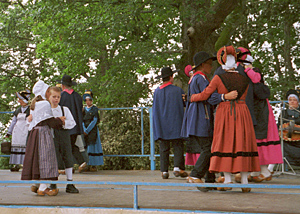 |
| Visitors to the thousand-year-old Chambérat fair
are greeted by the traditional dance of Auvergne, the Bourrée. It was introduced
to the French royalty fairly recently--in 1565. |
In fact, there is a case to be made that the fair was an outgrowth of a Celtic pagan
festival for the god Lug, perhaps in the Sixth Century. The festival fell between the
summer solstice and the autumn equinox.
Ever since it was Christianized, the fair has taken place in August on the Monday
after the Catholic holiday of the Assumption of the Virgin Mary.
Each August, when the fair rolls around, Claude says, "Let's buy a donkey."
"A donkey!" I cry. "Not again, please!"
"I've always wanted one," she persists, "since I was a child."
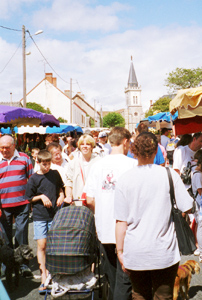 |
| Every August the small village of Chambérat is
packed with fair-goers who come from miles around. Babies and dogs are welcome. |
As a reason for buying a donkey, I guess that's as good as any, for childhood
dreams should never be dismissed lightly. And we do have the land, the stables,
even the hay for winter. But I've never liked the idea of adding such a stubborn animal to
our household, so I fall back on an old ploy to distract Claude from her determination.
I shift the conversation to food.
Since we're going to the fair," I say, "why don't we load up with peaches and melons?"
That stops all talk of buying a donkey--at least for the moment--and Claude begins to
recount her childhood memories of going to the fair with Panou.
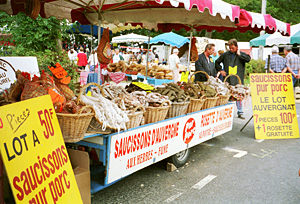 |
| I try to distract Claude from her idée fixe of buying a donkey by
talking about all the food we'll see at the fair. |
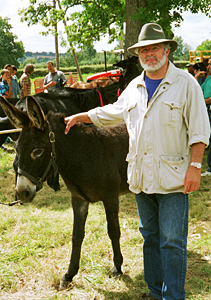 |
| My ploy works. No donkey. I bought a hat instead.
It's pure wool, cost 25 bucks--and I don't have to feed it. |
|